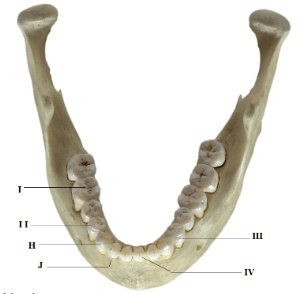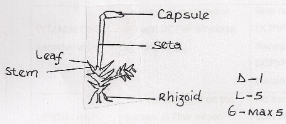INSTRUCTIONS TO CANDIDATES:
- Answer ALL the questions.
- Below is a photograph of an adult human jaw with teeth. Study the diagram and answer the questions that follow.

- State the mode of nutrition in man. (1mk)
- Name the type of teeth labeled I and III. (2mks)
- Name the parts of teeth labeled H and J. (2mks)
- Identify one distinguishing feature between teeth labeled II and IV. (1mk)
- State one function of tooth IV. (1mk)
- Write the dental formula from the jaw shown in the photograph. (1mk)
- Explain why tooth I would be more prone to dental carries than tooth III, (2mks)
- Use the hand lens provided to observe specimen K and answer the questions that follow.
-
- In the space below draw a fully labeled diagram of representative part of the specimen. (5mks)
- Calculate the magnification of your drawing. (2mks)
- Identify:
- The Kingdom (1mk)
- The Division, to which the specimen belongs. (1mk)
- Give a reason for your answer in b (ii) above. (1mk)
- State the functions of any two parts labeled in your diagram. (2mks)
- What is the mode of reproduction in the specimen? (1mk)
- Explain the significance of colour observed in the specimen M. (2mks)
-
- You are provided with solutions labeled L1, L2 and L3. Note that L3 is the same as L2 except that L3 has been boiled.
Label three test- tubes A, B and C.
Into the test- tube labeled A add 1ml of solution L1.
Into the test- tube labeled B add 1ml of L1 and 1ml of L2.
Into the test- tube labeled C add 1ml of L1 and 1ml of L3.- Withdraw a drop from test – tube A and place it on a white tile. To the drop add one drop of iodine solution. Record your observation in the table below. (3 mks)
Repeat the procedure with contents in test – tubes B and C. Record your observations in the table.Test-tube Observation Conclusion A B C
Place the three test –tubes labeled A, B and C into a water bath at 37°C.
NB. Ensure that the temperature of the water bath does not fall below 35°C or exceed 38°C - After 30 minutes, test the contents of each of the test – tubes labeled A, B and C following the procedure in (a) above. Record your observations in the table below. (6 mks)
Test-tube Observation Conclusion A B C - Why was test – tube labeled A included in the experiment? (1mk)
-
- suggest the identity of solution L2 (1mk)
- Give a reason for your answer in (d) i above. (1 mk)
- Suggest a part of the alimentary canal in the body of a mammal where the process being investigated in the experiment would take place. (1mk)
- Account for the results at the end of the experiment in the test – tube labeled.
- B (1mk)
- C (1mk)
- Withdraw a drop from test – tube A and place it on a white tile. To the drop add one drop of iodine solution. Record your observation in the table below. (3 mks)
CONFIDENTIAL
- Moss plant labeled K in a watch glass / peri-dish.
- Showing (Rhizoids, leaves, seta, capsule.
- Hand lens
REQUIREMENTS
Each candidate will require the following:
- 5 test - tubes
- 5ml of solution L1 – starch solution 0.5%
- 5ml of solution L2 – diastase solution 10%
- 2ml of solution L3 – Boiled diastase solution 10%
NB: boiled for 10 minutes - Means of labeling – 3 labels
- Water bath
- Thermometer
- Iodine solution
- 3 Droppers
- A White tile
- Means of timing
MARKING SCHEME
Question 1
- Omnivorous; (1mk)
-
- I – Molar; (1mk)
- IIl – Canine; (1mk)
-
- H – Enamel / crown; (1mk)
- J – Neck; (1mk)
- Teeth II has flat top / ridged while tooth IV has chisel shaped top. (1mk)
- Cutting / biting (1mk)
-
x 2 = 32 (1mk)
- Used more for chewing / has greater contact with food particles; // is flat broad ridged / cusped holds food remains;
Question 2
-
-
- mg = Drawing length = 20mm
Objects length 10mm
= x 2;
-
-
- Plantae;
- Bryophyta;
- Presence of;
- Rhizoids;
Male and female branches
- Rhizoids;
-
- Leaves – photosynthesis
- Capsule – spore producing
- Rhizoids – anchorage, absorption of water and mineral salts.
- Green contains chlorophyll for photosynthesis;
- Sporulation
- Green hence carry out photosynthesis / autotrophic
Question 3
-
6/2 = 3 marksTest-tube Observation Conclusion A Blue black/blue /black/bluish black; Starch present; B Blue black/blue /black/bluish black; Starch present; C Blue black/blue /black/bluish black; Starch present; -
6 marksTest-tube Observation Conclusion A Blue black/blue /black/ dark blue / bluish black; Starch present; B No colour change /brown/yellow colour / colour of iodine; Starch present; C Blue black/blue /black/bluish black; Starch present; - Control experiment
-
- Distase / enzyme /starch digesting enzyme/ ptyalin / saliva enzyme /salivary enzyme; (1mark)
- Because it is converted / digested / changed starch / can be denatured by boiling / acts within a range of temperature between 35°C – 38°C / optimum temperature; only 1 (1 mark)
- Mouth / duodenum / ileum;
NB (f) tied to table (b) -
- B – Starch absent / No colour change /colour of iodine remains because starch has been digested / converted / hydrolysed / broken down into glucose / maltose / simple sugar; (1mark)
- C - Starch present because boiling denatured enzyme /L2 ; thus starch not broken down / not digested / not acted upon;
Download Biology Paper 3 Questions and Answers with Confidential - Form 3 Mid Term 3 Exams 2023.
Tap Here to Download for 50/-
Get on WhatsApp for 50/-
Why download?
- ✔ To read offline at any time.
- ✔ To Print at your convenience
- ✔ Share Easily with Friends / Students


